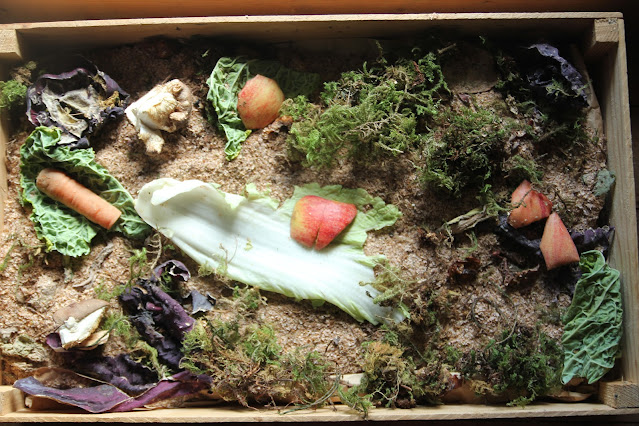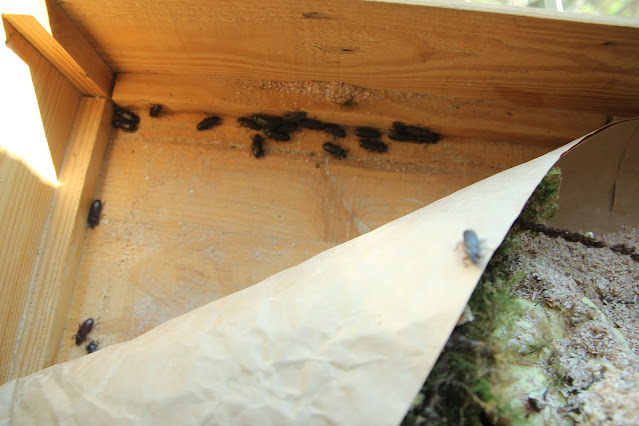As with all my work both writing and films, my intention is to share that observation is key in the understanding of how we can best raise our poultry. This also holds good for how we raise their food. Understanding how invertebrates live, reproduce and interact with their habitat, helps not only in time-saving and avoiding unnecessary labour but also in getting positive results. The first conclusion we came to was that the plastic box was not an optimum environment!
To this end we decided that creating our own mealworm box, from recuperated wood, could work much better both from a beetle-friendly aspect as well as enabling us to create a moist and yet not overtly damp environment that would encourage mould. This worked so well that the population grew quite quickly and we needed to make several more boxes, as it became quickly apparent that when there are too many invertebrates in one box, the food is speedily consumed and then they start eating each other. Part Two of the mealworm films below shows how we created these boxes. In Part Three you will also see how we modified them to accommodate for the different needs of the larvae and beetles.
Initially we used mosquito netting on the lids to allow a free-flow of air but this unfortunately also allowed mice to freely access the boxes and eat the mealworms! On occasions the netting also permitted both smaller worms and beetles to escape. This latter was not a problem however, as I quickly discovered that, as they were situated in the quail area, which had its own 'forest floor', this actually provided an optimum environment for the escapees. In fact at one point I toyed with the idea of maybe ditching the boxes altogether and just raising them 'in-house' as it were but then I realised that several of my quail have an insatiable appetite for mealworms of all sizes and that they would eat the beetles as well. To this end I replaced the mosquito netting with voile. Stopping the mice however was a problem! Therefore, we stacked the boxes allowing for a tiny air gap and topped this off with a metal ex-radiator grill on the upper box.
I also found that some of the mealworms, often those about to pupate and a proportion of the beetles, were comfortable congregating between layers of brown paper, which I recuperated from our local organic shop.
At this stage I was still unsure about the optimum moisture levels. I'd researched how these creatures lived in the wild and had realised that forest floors, general leaf litter and animal burrows were their native environment. They are however opportunists and will search for food in grain stores and kitchen cupboards, hence the name! It therefore seemed to me that these creatures actually needed quite a reasonable level of moisture in which to thrive but then there was the vexed question of the grain mite.
Using a cheap and cheerful supermarket microscope, it was soon evident that we had a grain mite population.
Acarus siro/Grain Mite Friend or Foe?
Much has been written about grain mites and their problem as a pest in raising mealworms and how necessary it is to keep the environment dry to avoid an infestation. However, I remembered the old adage 'What is sauce for the goose is sauce for the gander.' The fact that moisture and heat, as I found out last year in the Summer heatwave, can have an incredible effect on the prolific growth of invertebrates of all kinds, means that what is best for the grain mite is also best for the mealworm. Furthermore, given the size and the omnivorous diet of the mealworm, grain mites can be seen as just another food source.
Takeaways from Phase Two
As you will see from the film below, I initially despaired of the low number progression of mealworms to beetles to mealworms but once left alone with the requisite amount of vegetable and fruit matter, the population growth was incredible. In essence these are the bullet points:
- Mealworms seemed more at home in wooden boxes and the population growth seemed to confirm this
- Mealworms hatch out from their eggs, grow and pupate dependent on environmental triggers such as moisture and temperature
- Numbers per colony should be kept at an optimum (as per box size) otherwise they may become cannibals!
- Because of the above I was very wary of removing any of the bedding materials from the boxes, all I did was create another box and move the population into it
- The box, once the mealworms had been moved was left 'empty' or the contents were removed to another recipient and food was added. Over many months mealworms were still hatching out from this substrate and in their hundreds!
- A constant 'cleaning out' of the mealworms, as recommended in much of the literature I had read, is a mistake because that way you are certain of losing valuable eggs.
See you in Part Three!
Thanks for dropping by and do feel free to share experiences or ask for further information in the comment section. If you have enjoyed this piece and found it useful think about sharing it with your family and friends, on social media and also maybe about joining this blog and/or subscribing to my Youtube, Odysee or BitChute Channel or even supporting us on Patreon or
Until next time, all the very best from sunny Normandie!
© 2023 Sue Cross
It all helps to keep me going!
Until next time, all the very best from sunny Normandie!
Sue
© 2023 Sue Cross







Thank you for all the information. Very useful as I am going to raise mealworms for our ducks.
ReplyDeleteI was considering raising mealworms but did not because I do not like the plastic containers that are usually used for this purpose. I like your wooden boxes and leaf litter a lot, they make so much more sense for me, thanks a lot!
ReplyDelete